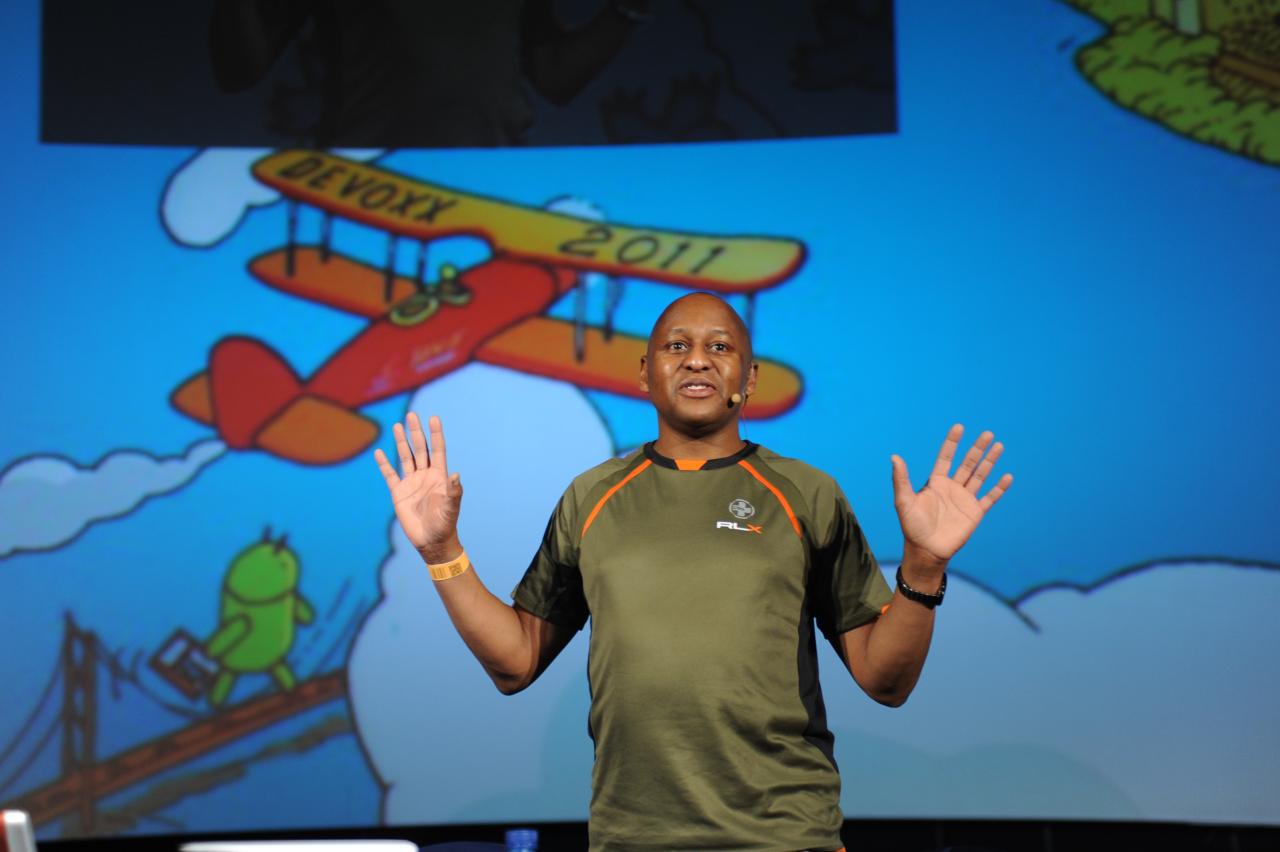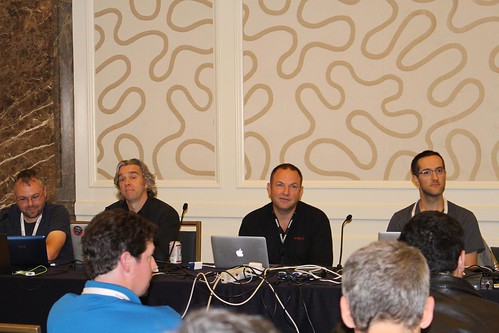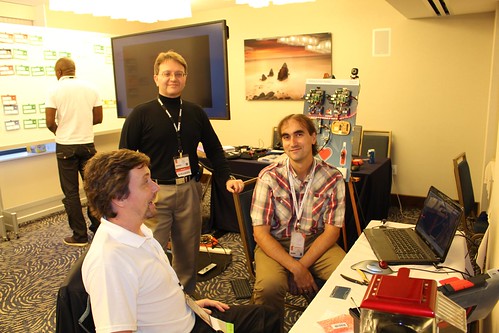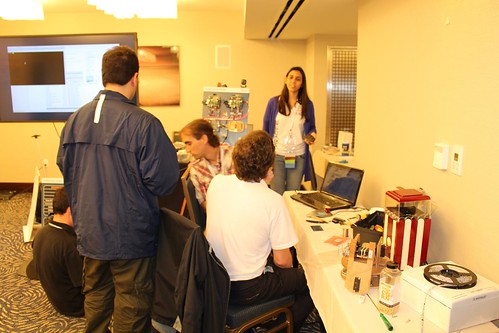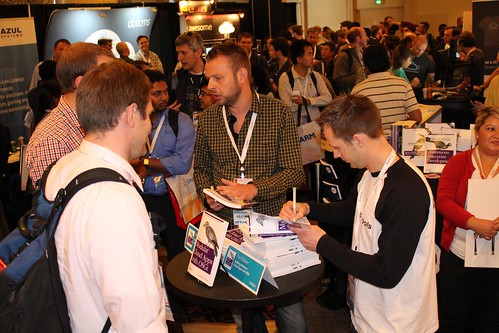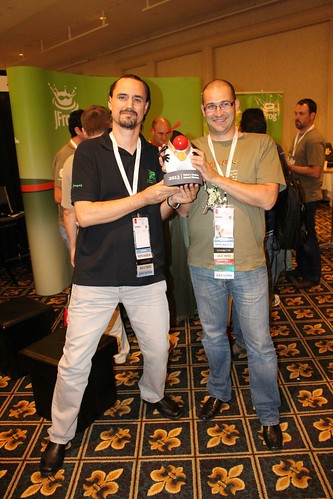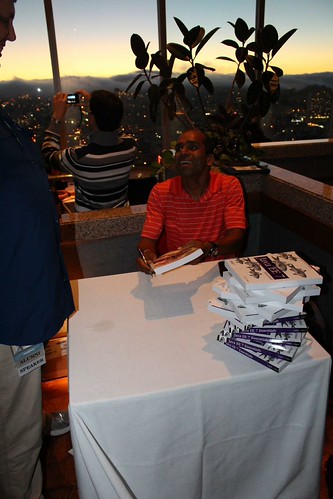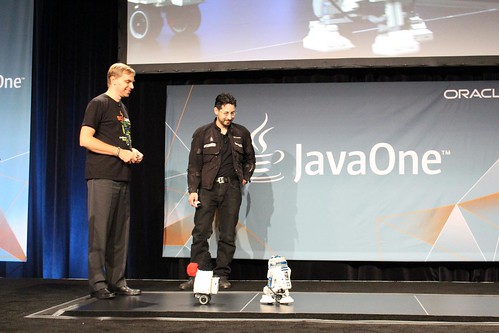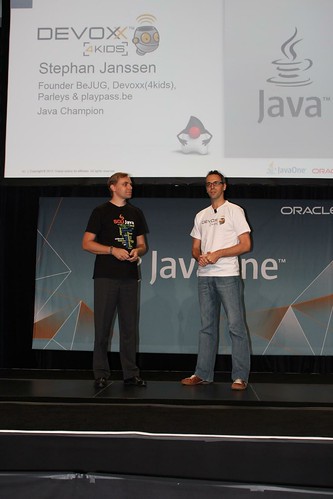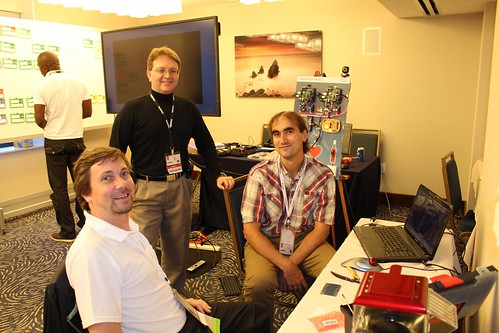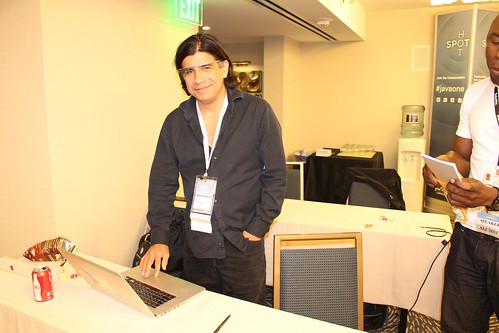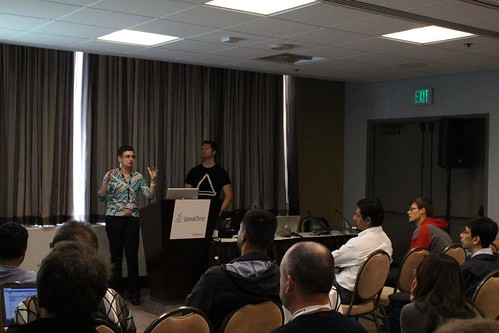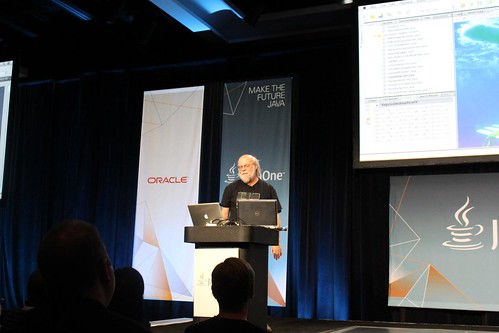JavaOne 2013 Report Part 2
01 October 2013 7 comments
Reading time:
13 minutes
Word count:
2735
My name is Peter Pilgrim. I am a technical book author, a Java Champion, software developer and designer. I live in London, England.
In part one, I was said that I was surprised by the diversity of crossover technologies in the Java space. Naturally, it has to do with my chosen schedule that belies the topics that I caught my eye. JavaOne participants were strongly recommended to use the Schedule Builder to register for talks. As if to prove a point, as a speaker I registered on talks with just a week to go before the event. I noticed that certain sessions were already full and these included the hot topics on WebSocket and RESTful services in the Java EE spaces, and Lambdas. Even though I personally did not attend this year, anything to do with garbage collection and memory allocation were also full sessions.

Venkat Subramanian at JVM Languages and Java Integration.
How not to miss out on a technical session?
My own session, Test Driven Development with Java EE, started off with 84 people about 10 days to go, then a couple of days later, it had 125 days and then eventually on the day reached the fire control limit of 160 pre-registrations. I mention fire safety control because I got caught up in a nice hallway conversation and then arrived late to one of Venkat Subramanian‘s talks and the badge scanning people blocked the late arrivers from entry. They don’t permit entry when the maximum room capacity is reached, which is all the seating capacity and maybe 10 people physically standing in the back of the room. The scene did not operate like a nightclub either: the one-out, one-in principle, because they do not know whether the attendee is just going out to return in order to get a coffee or take a leak. So if you want to get the best of learning of JavaOne, it reads like Jimi Hendrix, don’t be late! [see lyrics to song: Purple Haze, 1966]
My sessions pre-registered were:
| Subject | Start Date |
| UGF9871 — GlassFish Community: The Foundation for Opportunity | 9/22/13 |
| KEY11050 — Java Strategy and Technical Keynotes | 9/22/13 |
| UGF10339 — Cool NetBeans Tips and Tricks for JavaFX Development | 9/22/13 |
| CON7859 — The Road to Lambda | 9/23/13 |
| CON2176 — Use the Force, Luke? or Tips and Tricks for Using the Capabilities of JavaFX | 9/23/13 |
| CON2229 — Architecting Enterprise JavaFX 8 Applications | 9/23/13 |
| CON2231 — Demystifying Java EE | 9/23/13 |
| CON4456 — Coding Java EE 7: Making Easy Even Easier | 9/23/13 |
| BOF2887 — Java Persistence for NoSQL | 9/23/13 |
| BOF7857 — Using MongoDB in a Java Enterprise Application | 9/23/13 |
| CON2488 — Web Fundamentals | 9/24/13 |
| CON7941 — Lambda: A Peek Under the Hood | 9/24/13 |
| CON7771 — Nuts and Bolts of Java EE 7 Interceptors | 9/24/13 |
| CON2780 — OpenJFX: State of the Union | 9/24/13 |
| CON4510 — Fifty New Features of Java EE 7 in 50 Minutes | 9/24/13 |
| BOF5802 — No Guts, No Glory! A Deep Dive into the Internals of JavaFX | 9/24/13 |
| BOF2893 — Building Small Languages with Scala Parser Combinators | 9/24/13 |
| BOF7796 — GlassFish Community BOF | 9/24/13 |
| CON4279 — Test-Driven Development with Java EE 7, Arquillian, and CDI Containers | 9/25/13 |
| CON2258 — Of Raspberries, Dolphins, and Chickens: Visualizing Embedded Data with JavaFX | 9/25/13 |
| CON5389 — Groovy DSLs: Beginner to Expert | 9/25/13 |
| CON3496 — Come and Play! with Java EE 7 | 9/25/13 |
| CON2959 — Modular JavaScript | 9/25/13 |
| CON5723 — CSS Gold Nuggets | 9/25/13 |
| KEY11027 — Java Community Keynote | 9/26/13 |
| CON2079 — Designing with Lambda Expressions in Java | 9/26/13 |
| CON2494 — Be Creative and Create Your Own JavaFX 8 Controls | 9/26/13 |
| CON2406 — Java EE 8 and Beyond | 9/26/13 |
*Note: at the last minute, for some of these pre-registered session, when it came to the time, I changed my technical session or bailed halfway through and went another close by.
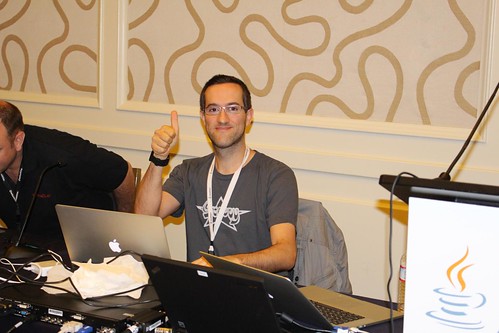
Guillaume Laforge wins the Scripting Bowl 2013!
Scripting Language Bowl 2013: (L-to-R) Dick Wall, Stuart Halloway, Jim Laskey and Guillaume Laforge.
Scripting Bowl
I returned to the Scripting Language Bowl session after a few years. There were some fascinating demonstrations, which were prepared of these languages. Dick Wall demonstrated the Typesafe Activator. Unfortunately he chose a netbook PC to show off the type classes and Scala compilation features. He did have an amusing code sample with type traits featuring Texan and Californian laws about who and what can get married together. The Clojure example from Stuart Halloway showed off immutable and data storage access with Datomic product. Jim Laskey demonstrated a fascinating JavaScript game example and Guillaume Laforge showed off GroovyFX with some JavaFX 3D. Guillaume LaForge was crowned the 2013 winner.
This is the fellow that took a photo of me in front of the NAO robots on the exhibition floor.
Embedded Challenge
Hidden away from the main conference on the fourth floor of the Hilton Hotel, a challenge was afoot. Oracle organised an Embedded Java Development Challenge on the Raspberry Pi. There was certainly a lot of engineering going on secluded from the beaten path. I spent about 35 minutes only in the room and yet it was a hive of activity. Developer hooked up various Raspberry Pi devices and had consultation with a mentor into projects. Projects varied from monitoring temperature in a room to analysing blood sugar. One person brought a complete home automation system to the conference to demonstrate the Java ME 8 and Raspian Pi integration.
Embedded developer guys: Mark Heckler (standing) and José Perada (r). The real organiser of the embedded is in profile (l) Vinicius Senger. In the background is the Max Bonhbel hanging around and reading the postcards on the storyboard. Each postcard was a proposal or task suggestion.
Embedded developers 2
Embedded developers 3: these Brazilian fellows were hacking the home automation system.
Embedded developers 4 Bruno Borges is supplying advice and listening to queries.
Embedded developers 5 (Yara Senger, the organiser and one of the facilitators, is at the back is looking forwards). The red and white box contraption is a popcorn maker machine. If you look closely you can see the jar of popcorn seeds next to the green screwdriver, and yes I think they did attempt to connect one up to a Pi! I’m unclear about the roll of wire of plastic in the bottom right of the photo, whether it was for a 3D printer or not.
If Oracle run the embedded workshop again next year at JavaOne, then be sure to sign up. I think even though I was briefly, ever so, there that the challenge was successful. You should bring your own version of the Dukepad, and hook it up to something really special.
At the Thursday keynote, Oracle said that they signed an OEM agreement with the Raspberry Pi Foundation to deliver Java with Raspberry Pi.
Exhibition
The exhibition was a tremendous success this year, because the organisers added one special trick to the JavaOne schedule. For the Monday, Tuesday and Wednesday of the conference, between the hours of 2pm and 3pm there were no conference sessions. This meant that developers had a chance to visit the exhibitors every day. One small hiccup I saw and witnessed was the food and beverages that were laid, because I am English, I shall, early tea time. Yes the American style hors d’oeuvres were rather biscuits, cookies and crisps, however much to chagrin of exhibitors and delegates, the catering staff whisked all of the coffee, tea and food away on the dot of three o’clock.
There were some nice people and the usual favourites on the floor: Red Hat, JFrog, ZeroTurnaround and Gradleware. Of course Oracle had a whole area dedicated to demonstrations, which is a lot smaller than the huge Sun Microsystem stands from yesterday. Even IBM was a just regular stand on this occasion. I spent time at the PluralSight stand and learnt about their online education course offerings. I met David Blevins there as the new CEO of a company called TomiTribe, which is now a software support model around his project, TomEE. Actually, TomiTribe was sharing exhibition space with JElastic, which is the PaaS cloud provider company that Liquid Robotics and James Gosling uses for the oceanographic robots.
O’Reilly bookstore had a stand at JavaOne, and they also had book signed with author, who were at the conference, like Paul Bakker. Sander Mak was his buddy in support.
Paul Bakker (l) with support from Sander Mak (r) during his OSGi Java book signing at the O’Reilly stand. The modularity book was written by Paul Bakker and Bert Ertman. Look closely at how the queue is long and extends behind to the next exhibitor.
It was great to bump into Fred Simon again from seeing him last at the JavaPosse Roundup in Colorado. JFrog won a Duke award again. Congratulations!
Israel’s JFrog wins yet another salubrious Duke award; Fred Simon (l) with Baruch Sadogursky (r) is holding the prize Java mascot.
Arun Gupta signs his Java EE 7 book at the JCP party.
More Enterprise

Arun Gupta and Antonio Gonclaves at their joint session: 50 New Features in Java EE 7.
Java EE 7 had lot of talks, and one of them was pretty ambitious. Arun Gupta and Antonio Gonclaves had a session called 50 New Features in 50 Minutes, which was a very nice idea. I was there on the day, they managed to get 42 slides before they were told to quit. Apart from the delays there was some new features in Java EE 7 that fixed obscure bugs in the platform. The order of specifying interceptors through annotations is one of them.
On Thursday, I went to last conference session of the JavaOne, which was Java EE 8 and Beyond. The session was a panel of five famous folk: Cameron Purdy (Oracle), David Blevins (TomiTribe), Mark Little (Red Hat), Brian Martin (IBM), Scott Yara (Pivotal) and Antonio Gonclaves (Individual). Also in attendance was Arun Gupta and Ed Burns. For the record, the moderator of the panel was Mike Keith (Oracle).
I asked a question of the panel about the standardisation of Cloud PaaS services, they opine that Java EE 8 should probably look at a less goal first, being able to provision services, starting and stop servers and administrative resources. It was clear that they felt Java EE 8 should be focus on adding support for DevOps. There were other questions, one attendee asked about JavaServer Faces templates using as separate API. Other questions, were around idea feature that the panel would definitely like to see in Java EE 8. Antonio Gonclaves wanted a logging API and the audience roared with laughter. It is ironic that logging does not be a API standard, when we have to contend with Log4J, SL4F and Commons Logging. There was a question on the role of EJBs, and whether eventually they should be phased out. Blevins was off the opinion, that EJBs can be considered a special case of CDI beans, from the implementation standpoint. He thought that the @Stereotype annotation could be extended and therefore the existing @Stateless and @Stateful could retrofitted as stereotypes. The basic idea @Stateless would have reference to @Transactional, @Asynchronous, etc. Still one other panelist thought maybe it is time for renaming Enterprise Java Beans, because of their history to something else entirely, such a service entry or endpoint.
We shall how see Pivotal and SpringSource get involved with the JCP and the Java EE 8 specifications. The audience witnessed some of the uncertainty of SpringSource and the expert group. Antonio Gonclaves particularly was scathing, “if Spring never embraces CDI then it won’t be Java EE, because CDI is getting more in grain with EE.” I sympathise with some of this view as the Java EE 7 specification stands exactly now. With Pivotal taking a renew interest in the JCP, we may see a different outlook in the next year. Scott Yara said, “Pivotal were building database engines before NoSQL and Hadoop ,nobody was interested. They wanted open source scalability.” and he also had more positive outlook for future endeavours, “Spring is really supportive of Java EE specification.”
Keynote
Thursday keynote summary:
- Oracle signed an OEM deal with Raspberry Pi Foundation to supply embedded Java
- Lambdas specification Java 8 is going to be evolve the entire platform forward. Java, the mother language of the JVM, has extended life with the functional interfaces.
- Internet of Things is now on cusp of being something larger, especially with mobile Java 8 platform
- Duke award winner, Devoxx4kids, is part of a wave of education for children and also for allowing girls to start a career in IT. 35-45% of Devoxx4Kids participants have been girls.
- James Gosling demonstrated live connection to Liquid Robotics devices, which show cased the Java platform on embedded through to enterprise.
At the community keynote, Stephen Chin demonstrates embedded Java ME 8 with robotics. In the picture you can see LEGO mindstorm creations of the Java duke mascot and an working R2D2, which was later stolen from his motorcycle, sadly.
Stephan Janssen is on stage with Henrik Stahl discussing the award-winning Devoxx 4 Kids project.
Here is the face of Vinicius Senger, finally, who truly was responsible for the embedded challenge.
Dario Laverde of the New York City JUG and New York City Google Developer Group is wearing his Google Glass. He also had a project to integrate Google Glass with Java ME 8 and Raspberry Pi.
The General Consensus
I have the feeling that this JavaOne 2013 was the best conference since Oracle co-located the 2010 version with OpenWorld. It was very good for technical content and there was lots of diverse content of interest to a spread of many people. Of course, I did not go to the security track, which was very new. I spoke to one guy, who said it sometimes excellent, but on other session it was so-so, the speaker spoke about his or her company marketing product. Of the sessions that I attended, I almost saw all of the pre-registered list. I admit that I changed some sessions at the very last minute. For example, I went to the Parleys session on JavaScript modules instead of the pre-registered JavaFX talk at 3pm on Monday.
The big take away is to get your into Lambdas and functional programming in Java.
Server side JavaScript is now viable contender for executing on the JVM properly with the Avatar project and Nashorn.
Developers are very serious about JAX-RS providers and solutions. They are sort of interested in WebSocket and the protocol is for early adopters only at this point.
Client side JavaScript is very important for practising Java developer, especially working HTML5, JSF or other templating technology. It worth studying JavaScript frameworks beyond JQuery for dependency injection. In conjunction with JavaScript, developers should study CSS techniques.
JavaFX is still chugging it way through. JavaFX 8 shows great promise with the 3D graphics nodes and yet it will require some exciting use cases in order to show off the abilities. Oracle will not deliver a port to iOS or to Android, however they have almost open sourced the entire code base and therefore individuals and companies may want to take over this effort.
John Yeary (l) and Sharat Chandler (r) are having a quiet word. Sorry to have interrupted your delicate conversations, fellows, and thanks for your courtesy.
Here is a Groovy Connection: Java Champion Andres Almary (L) stands with Oracle’s Sharat Chandler and Andres’s partner (R) Ixchel Ruiz.
This is the Interceptors 1.2 (JSR 318) session with (l) Marina Vatkina, who was responsible for JSR and Emmanuel Bernard (r) of the Bean Validation 1.1 specification.
The Buzz House Cafe fire, which everybody grew to love very much. San Francisco can be quite chilly in the evenings especially if you go out in the morning with just a tee-shirt.
A 10 year old Aditya Gupta (son of Arun) is demonstrating TNT explosions, which he created on the Minecraft Java platform.
Here is James Gosling at the Thursday community keynote talking about the Liquid Robotics out in the pacific. He actually managed to get a live video stream to one of these robots in the ocean, which was quite frankly outstanding. James Gosling also pointed out the weakness of HTML5 and CSS current standards to handle 3D graphics and map visualisation and said that JavaFX 3D can handle it well. He also announced that Liquid Robotics will be open sourcing a Map component in the near future, once it had gone through the necessary legal channels. The map component is a better-than Google Earth and it uses the Open Street Map specification and implementation. I think this be of certain interest to many industrial sectors, businesses and individuals who need a mapping solution that works with JavaFX.
The end of yet another conference day with this view outside Moscone Center West across the street.
+PP+

